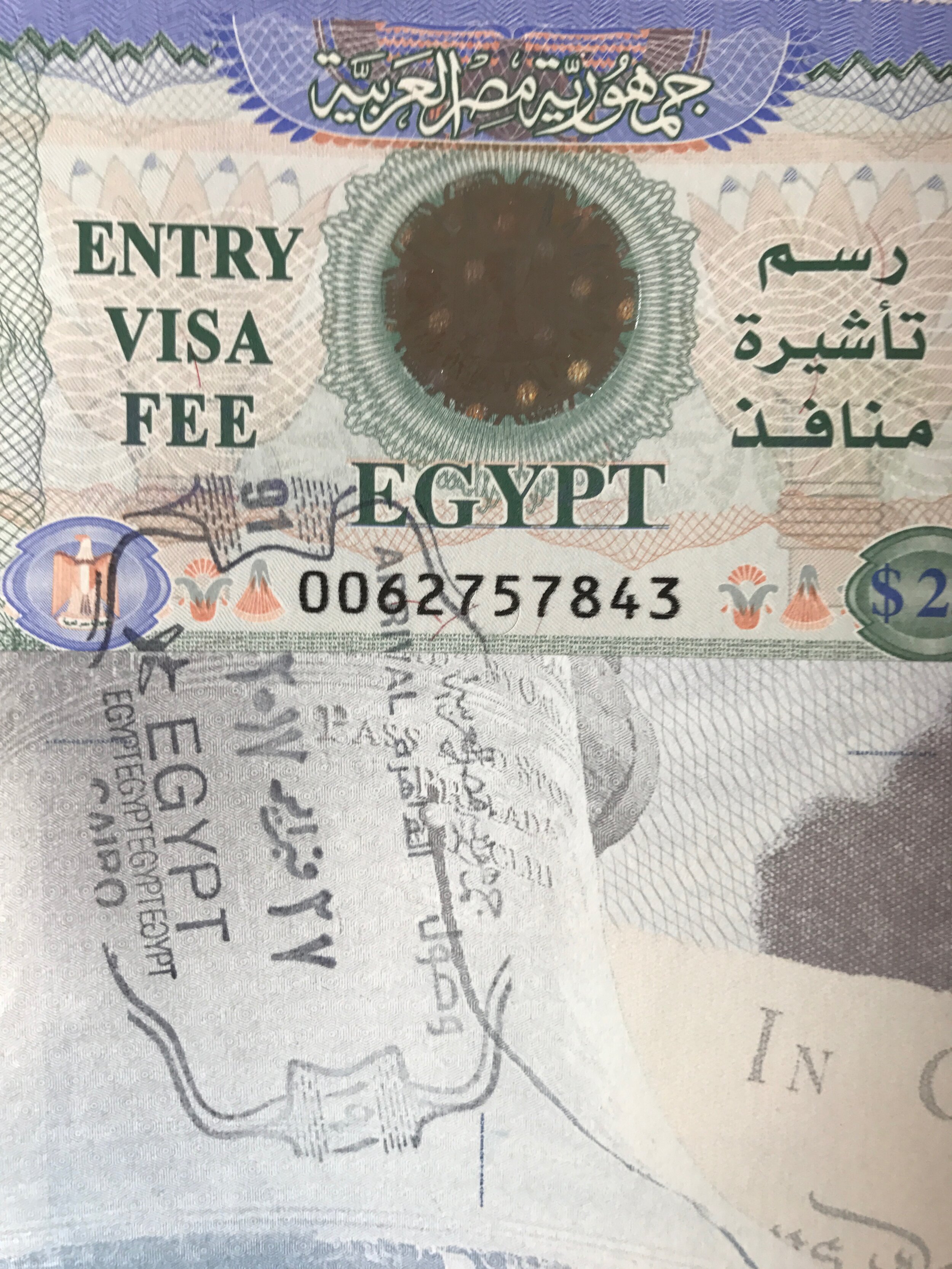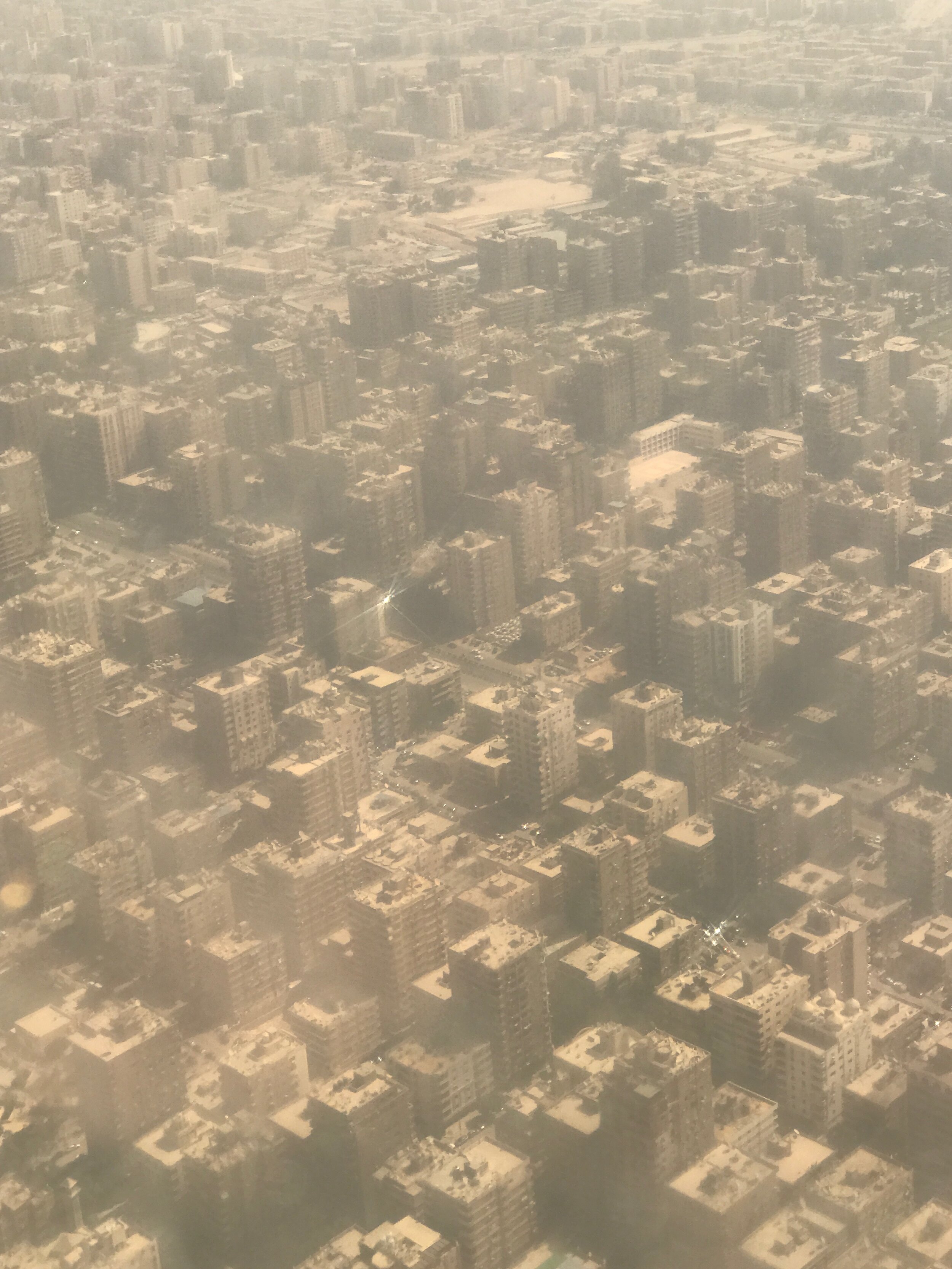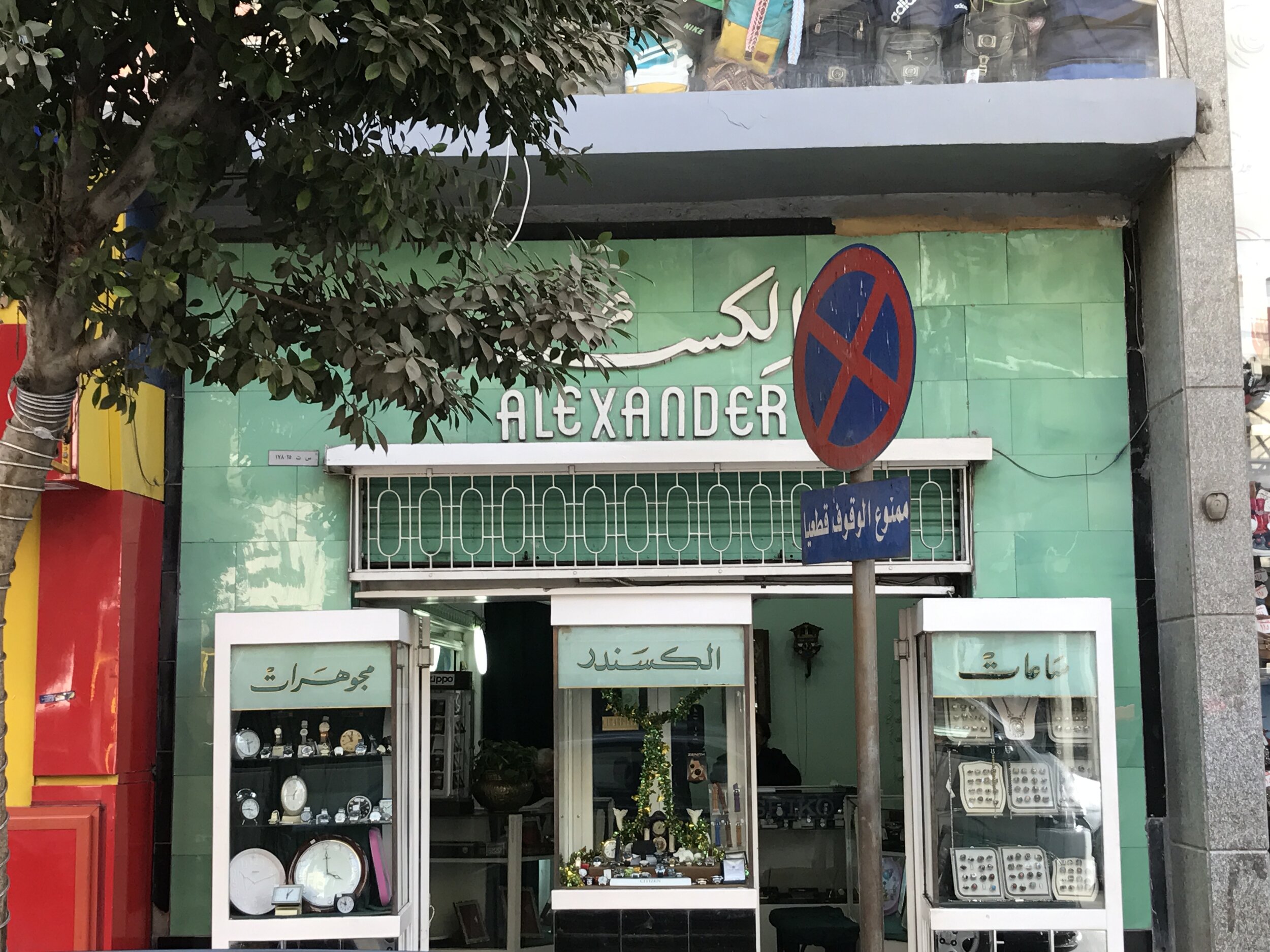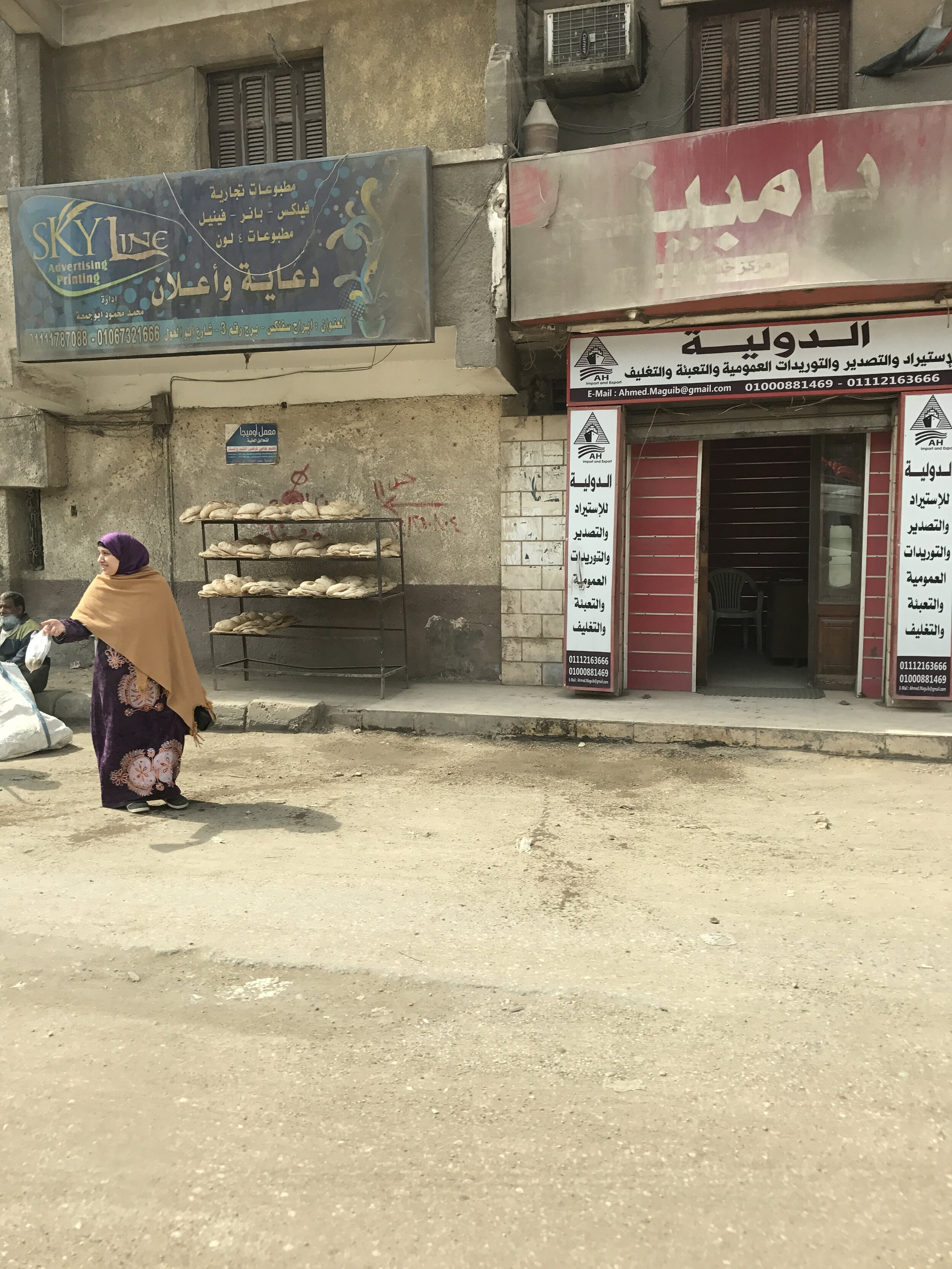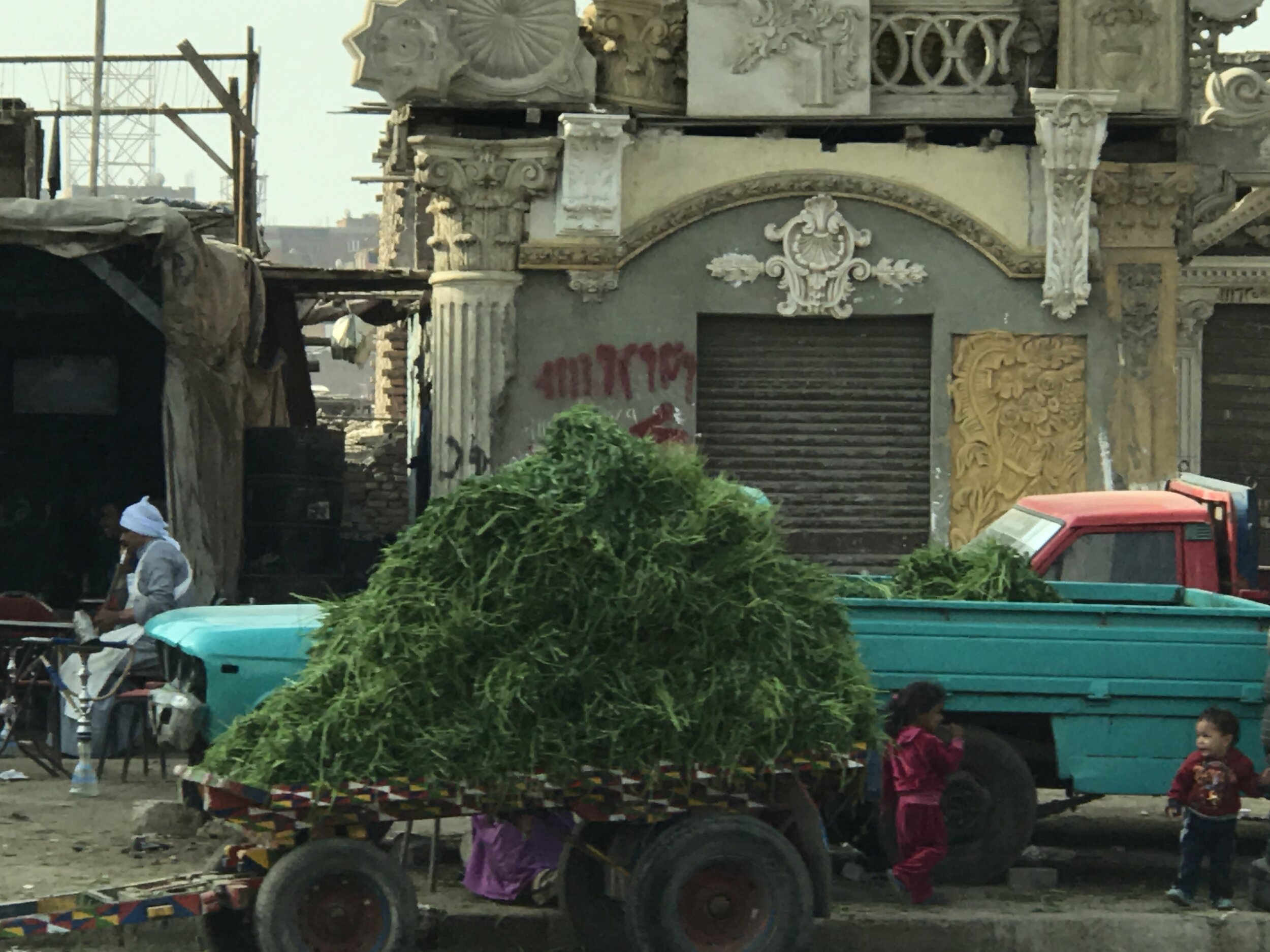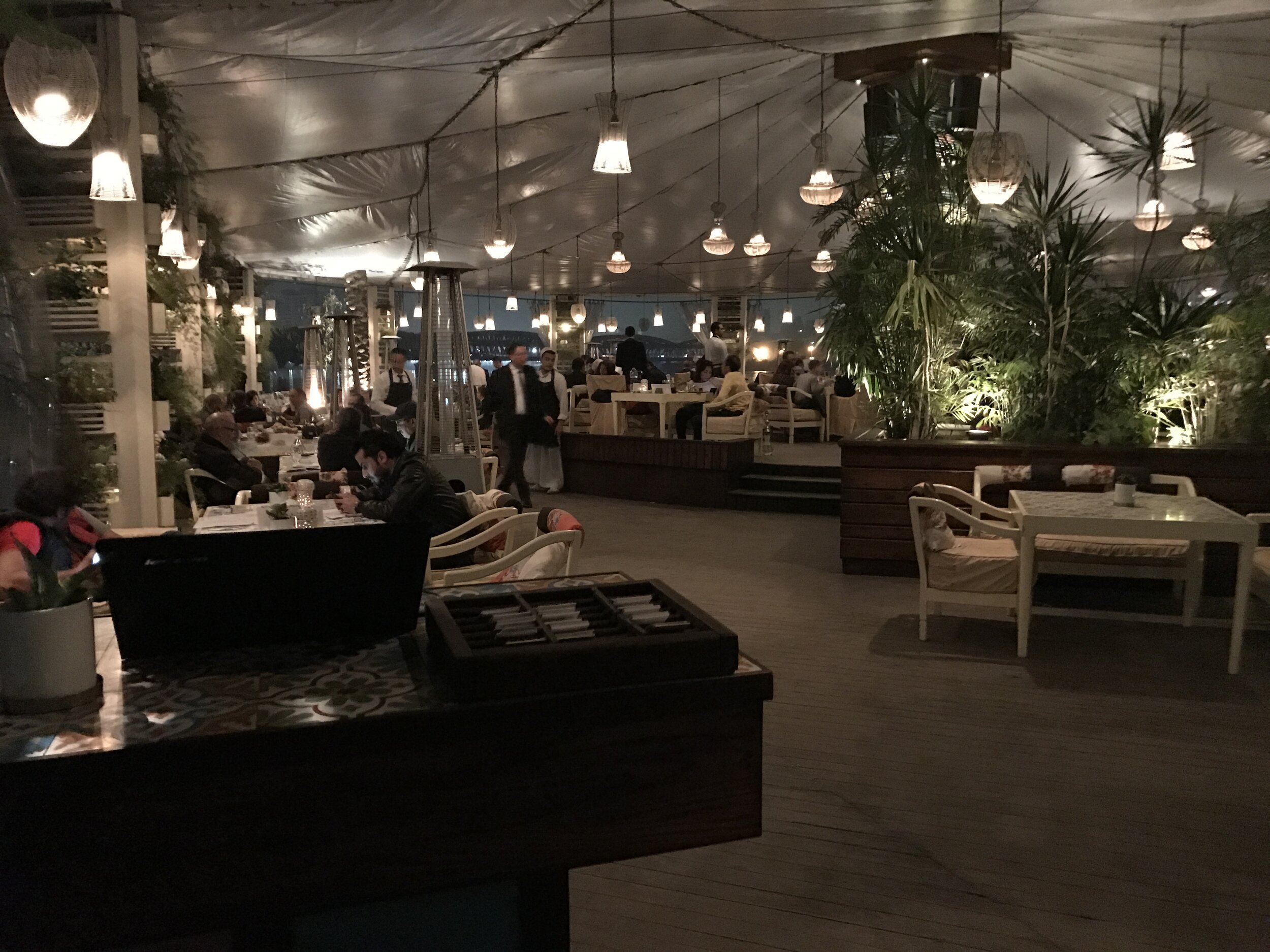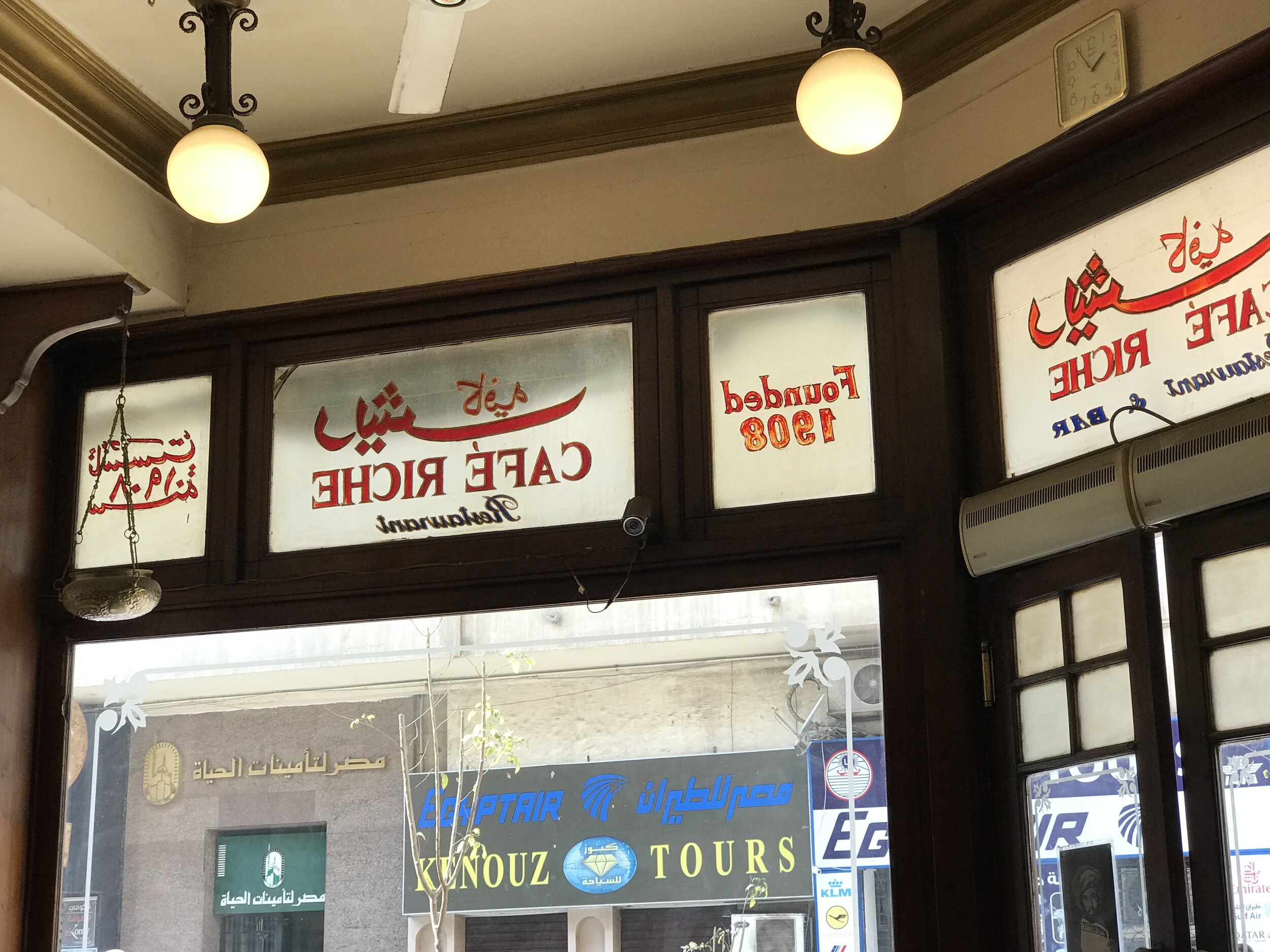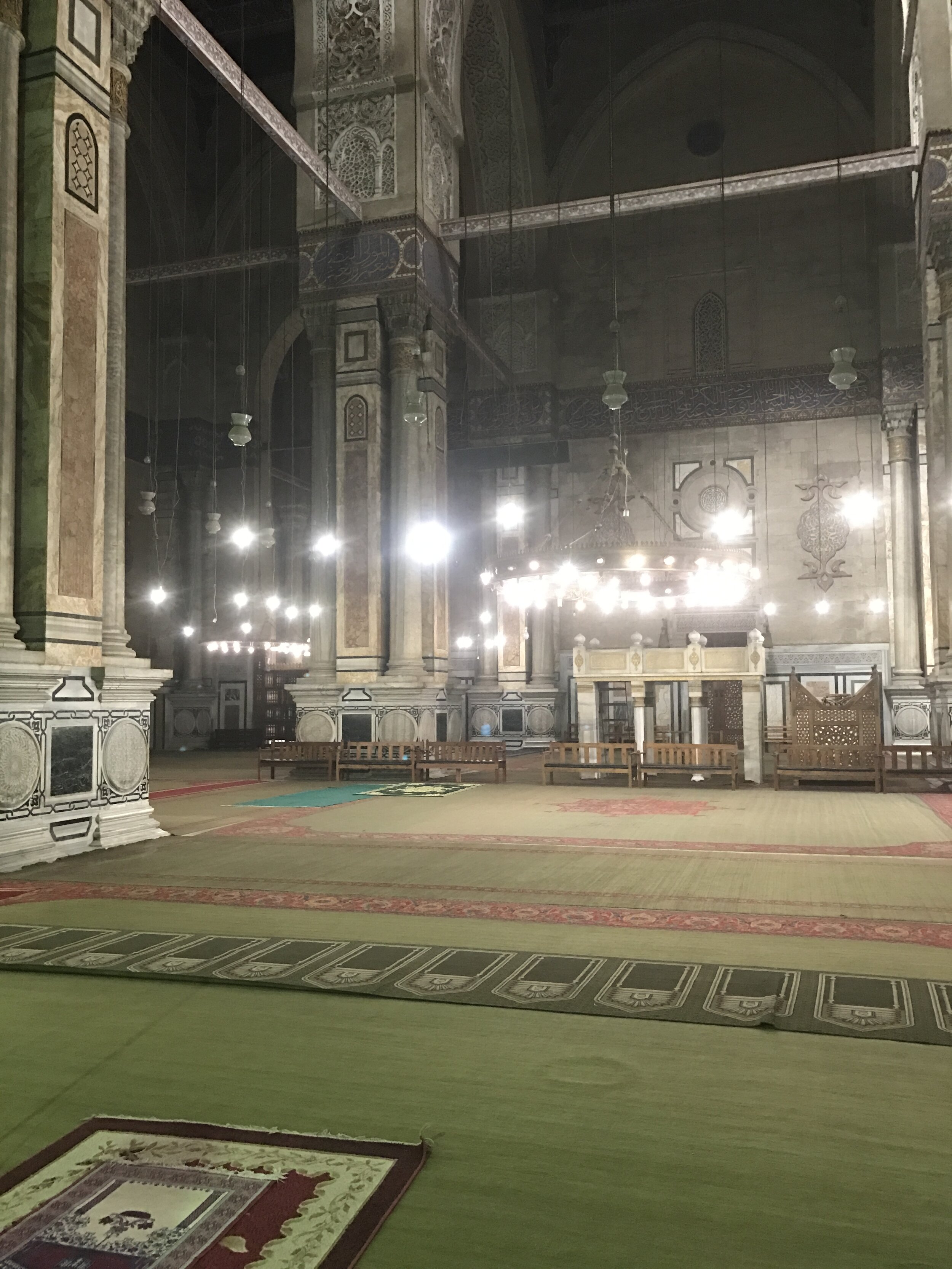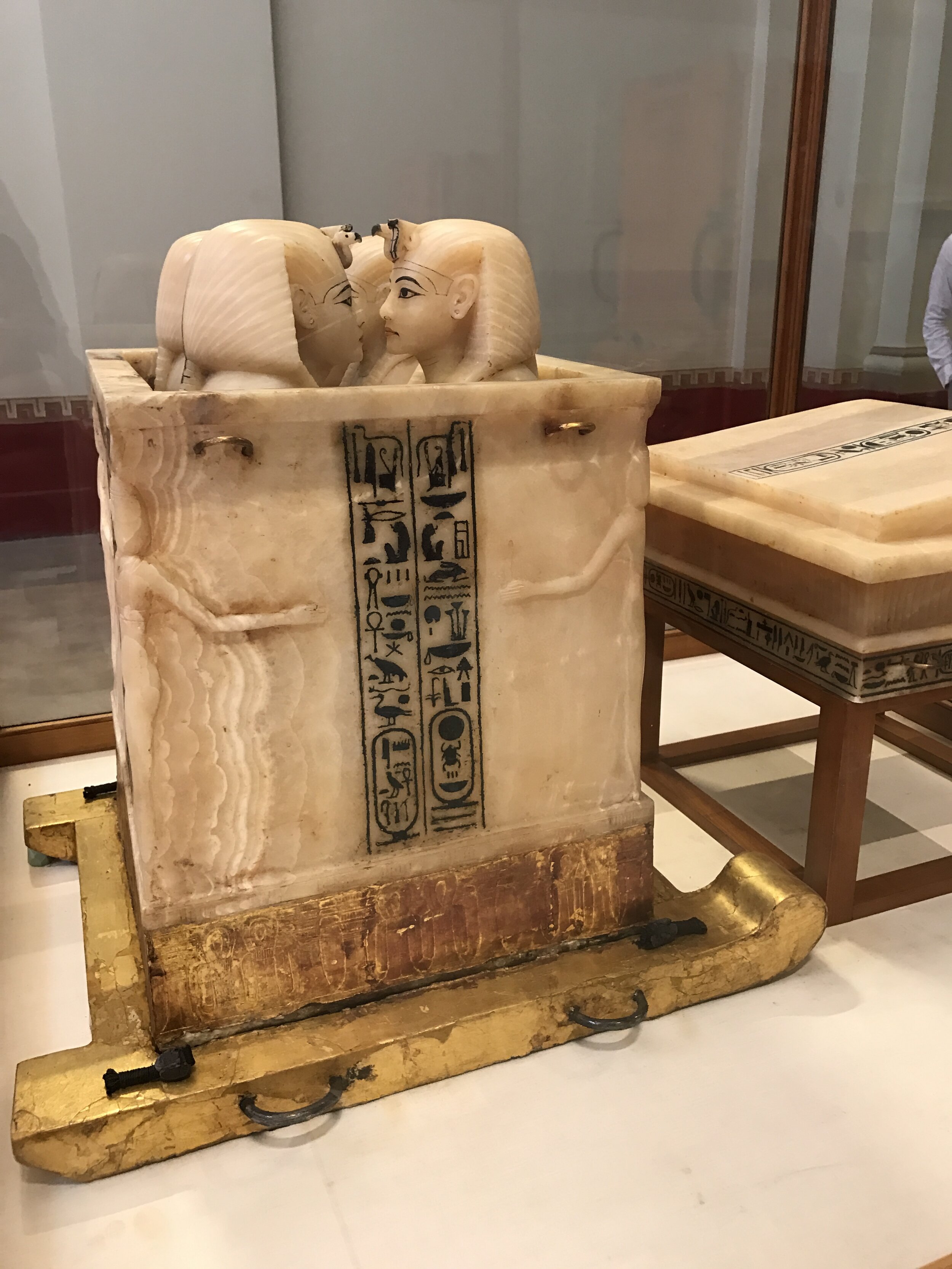[Visited In February/March 2017]
A. and I wanted to take a trip as a break from the last two years of building our apartment in Tel Aviv. We wanted to visit somewhere we hadn’t been, something close by, and somewhere where I didn't have to wear a burka (a consideration when one travels in the middle east) and it had to be warm. This is a challenge in winter. So we kept circling back to Egypt. Egypt is very close to Israel, you can drive there in the same time it takes to drive from SF to LA. Using this logic, flying there should be a one hour flight. But when we searched the Rome2Rio and Kayak Apps they both revealed that one needs to spend, depending on airlines and routes, somewhere between 5 - 10 hours to get there. After some internet sleuthing A. uncovered a secret direct flight from Tel Aviv to Cairo. One flight a day, 7 days a week, in both directions. It’s an Egypt Air flight flying under the name Sinai Air. I say secret because you can’t book it online, they don’t advertise it, and you can only get a ticket through a travel agent or by visiting their office.
We have a concierge service in Tel aviv that we use to handle things that need to happen when we aren't there, to help us read our bills which are all in Hebrew, and to do normal concierge stuff like book restaurants, etc. It’s especially necessary when building an apartment in absentia. They have a travel specialist in their office and we asked him to book the flight for us. “But there is no such flight,” he told us. We insisted, and, after calling the Egypt Air office and speaking with a representative, he was shocked to find there was such a flight, and he was happy to book it for us. Although the flight number and destination exist on the departure screens at TLV airport, at the Cairo airport you see only the flight number, no destination. Let's just say they don’t advertise Tel Aviv as a destination.
We were so excited we told all of our friends - Israelis and Americans - most had less than enthusiastic remarks. We were met by many “Really’s?”. Or, “Well, If you are traveling on your American Passport, you should be okay,” another not so re-assuring remark. A friend from LA texted me a nail-biting, terribly worried looking Kermit the Frog gif that played over and over on my iphone. Hmmmmm. But we were excited, confident, and undeterred. That is until 5 days before we were to leave, we received a call from an Israeli friend, who had a journalist friend, that had just returned from Cairo. “I just couldn’t keep this to myself,” she started, “But a friend of mine just returned from Egypt. She was detained and questioned at the Cairo Airport by Police for 2 hours. She has been covering Egypt for 14 years and nothing like that had ever happened to her before. She said the atmosphere there is explosive. Sorry, I just couldn’t keep it to myself, I thought you should know….”
We paused, but we honestly weren’t feeling shaky about it, and kept to the plan. Then I decided, because of all of the skepticism and dire warnings, to seek some sort of re-assurance. Something that would give me peace of mind about our decision, so I emailed Stella the Good Witch, our Astro-cartographer. Stella lays our natal astrology charts over a map of the world and looks at where we are personally and how that overlaps with what is going on at the time of the trip, in any given place. Stella was recommended to me a few years ago because of a very complicated itinerary A and I were planning. Two days before we left, Stella confirmed that we chose a good time to go and said things wouldn’t heat up until April. *
Israel is roughly halfway between Beirut and Cairo and has gone missing on this in flight magazine!
The flight was 1.5 hours, we were 2 of the 10 people on board, 4 of which were the flight crew. The descent into Cairo gave us a dramatic view of the sand-dusted post-apocalyptic desert landscape.
We were met at the airport by Ali whose company curated our itinerary. The drive to the hotel was an adventure in itself. The traffic is a chaotic mix of cars, tour vans, buses, motorbikes, horse-drawn carriages and pedestrians who walk perpendicular through it all like moving targets. I noticed the bravery and confidence of the people gliding in and out of traffic, sometimes within an inch of their Jalabiyas. I asked Ali if many pedestrians are killed. He responded with “The hospital is just here, if we hit them, we can drop them off afterward.” A moment later he added, “In Egypt, crosswalks and traffic signals are merely a suggestion.” He shared with us the secret to crossing the road in Cairo. It is first, do not hesitate and second, go at a steady pace so the drivers can gage where you will be when they get close and they will go around you. It takes us more than an hour to get to the hotel and Ali tells us its rush hour, and adds that “In Egypt, rush hour is 24 hours a day…”
Downtown Cairo has several well preserved Art Deco buildings
I love these tailored car covers
At the hotel every car is searched with metal detectors and bomb sniffing dogs. At the entrance beside the guard booth there is even a permanent dog house. We had a Nile view room which was upgraded to a Nile view Suite. You know the tourism industry is hurting when a room of that category at the Four Seasons goes for less than $250 US a night. Across the river are all of the usual hotel brands: Sheratons, Sofitels and Ritz Carltons, luckily no Trump Hotel to mar our exotic experience and remind us of the chaos in the US.
Marble dog house with air vents
We had a late lunch at the hotel restaurant. I was shocked when the maitre d’ asked if we preferred a smoking or non-smoking table before we were seated. It’s been a long time since I’ve heard that question. I would say Nicotine is one of the defining scents of Egypt, whether its from a cigarette, cigar, or apricot-laced shisha smoke. There was a bland buffet of American, European and Egyptian foods. I think hotel buffets tend to target the lowest common palette.
Not daring to cross the street and stroll along the Nile, after lunch we explored the neighborhood around the hotel. It was filled with grand old european-style buildings which housed most of the Embassies. The air was a smoky dusty mix, filled with the echo of incessant horn-honking. Attached to the hotel was the Beyman Mall, a high-end store featuring local artisans, European designer clothes, and fancy linens and sheets. We happened to be in search of sheets and during my research I discovered that most of the Egyptian-grown cotton is shipped out of the country. This was confirmed when the highest quality sheets I could find were Frette from France.
Hand-painted caftans
Cairo Pillo
We felt so safe exploring on foot, in the evening we went to the Jazz Bar at the nearby Kempenski Hotel. We had martini’s and took in the glittering view of the Nile at night, listening to Billie Holiday sing ‘What a Little Moonlight can Do.’ Indeed.
The Nile at Night
A campaign by the Swedish Embassy to promote awareness for the hearing-impaired
D A Y 2
We woke up to a misty morning haze that covered the hotels across the river, which made them blurry with an orange glow from the street lamps. The buildings are stacked far into the distance - a never ending expanse of towers helping to house the 20 million people that live and work here. The apartments, offices and hotels are a mix of earthy colors: sandy yellows, brick reds, and muddy clay browns that fade easily into the desert beyond the city. The Nile is a deep olive color that divides Cairo and Giza and reflects the shimmering glass and metal buildings on its banks. The bridges that cross the river are sprinkled with cars leading up to the 7am morning rush hour.
The breakfast buffet was much like the lunch buffet the day before, but sprinkled with a few Egyptian specialities, a welcome alternative to eggs. I try Tamia (Falafel) and Egyptian salad (same as Israeli or Lebanese chopped salad) and Fetteri. Fetteri is something you can only get in Egypt. Its a many layered buttered pastry that they cut like a pizza. Another version of Fetteri is shaped like a crescent. The legend is that the crescent shaped Fetteri made its way to France and became the Croissant. The Manager of the dining room was excited to have me enjoy it in just the right way - so he personally smeared it with equal parts molasses and tahini and served it with a Turkish coffee. It was delicious, a great start for a day of sightseeing.
Power Breakfast
Giza Pyramids
The guide and driver met us at 9am for our first view ancient Egypt. On the drive to Giza the landscape changed from European Style buildings into tall unfinished cinderblock towers. The towers were 9, 10 stories and built on land reserved for agriculture, but because of its proximity to Cairo and the Nile, it was far too valuable. So, they were sold armers who sold them to builders. The builders then sell the flats, and the flat owners agree to finish the inside, leaving the outside unfinished and seemingly abandoned. These are all cash deals with no paperwork because paperwork would make it an illegal sale. “No system is a good system here” our guide volunteered.
Almost Buildings
After a quick stop to buy tickets and check in with security, we drove up to the Pyramid. Local men walked around with their decorated camels. No waiting, no lines, hardley any tourists. Our guide pointed to the buses in the parking lot, “there are usually 60-80 buses” he said. I counted 8, most of them filled with Chinese tourists. We saw them buying souveniers - wooden carved pharaohs, felines and pyramids. A. looked at one, and on the bottom it said Made in China.
Back in Time
Made in China and borrowed from the internet….
There are 116 Pyramids in Egypt, 9 in Giza, 3 of them famous. The main pyramid was for King Keops, his son King Keferan, and his grandson King Mekarinus. The pyramids were built of stone quarried on site. The stones could be up to16 square metric tons. They were believed to be pulled on the sand by armies. But how to lift them into place? No one knows, there are theories though. The best one is that they built ramps of mud that they would wet so that it was slippery enough to pull the stone on top of an existing stone. Each Pyramid has two smaller pyramids to the east - one for embalming the body and the second for the last prayers before burial.
The Queen mothers and daughters also have nearby pyramids, but not the brothers. Why? Because in the religion the responsibility to make a Pharaoh (King) falls to the women, they are the “Kingmakers.” Isis ‘made’ (I am assuming gave birth to) Horace - the 1st king.
The belief is that a pyramid is basically a stairway to heaven, the connection between Heaven and Earth. The Egyptians believe that the king of Egypt is a god created by the sun (or the solar disk as they call it.) The tip top of the Pyramid was covered in gold so when the sun would hit it, it would reflect the suns rays so the Kings soul could ascend back to the sun god, Ra.
Even though the Egyptians (in 3000 BC) believed the world was flat, they knew that the sun took two journeys a day, East to West (sunrise which represents rebirth) and West to East (sunset which represents the journey into the underworld.) If you are a dead king, this journey takes some time and some interrogation. They believed that in the underworld there is a 14 panel jury that gets to ask three questions each (for a total of 42) about the life of the recently deceased.
There is a Papyrus guidebook of the hours of these juries and the questions. For example in Hour 6 the heart is weighed on a scale with an ostrich feather (a symbol of honesty/truth/kindness.) If you are a bad person, Ammit, the demon goddess dubbed “Devourer of dead” (a lion/crocodile/hippopotamus combo monster) will eat the heart, so that person will never return - because you can only return with all of your parts. If a sinner was up for judgement he/she would buy a scarab and write a magic spell on the bottom to tell the heart not to fail the weight test that day. The larger the heart scarab the bigger the sinner.
The biggest Sinner is on the left
Back in the day Egyptian Kings, or Pharaohs, would put all of their energy (besides doing their day jobs - ruling, etc.) into building themselves a tomb to enjoy the afterlife, which they believed was eternal. Daily life for them was temporary. So all of the pyramids, temples, tombs, mummification, and storage of their personal affects - was to glorify the eternal life and insure that when they returned they would have everything they needed. They also believed that when you return your soul is 20 years old. This interested me. “What if you die and they mummified your body at 60 or 70?” I asked our guide. “Then you have the body of a 60 year old with the soul of a 20 year old.” He said. Imagine how looking in the mirror would feel in that situation.
The Egyptians had 30 Dynasties in 30,000 years. They broke the governments into the Old kingdom, Intermediate Kingdom and New kingdom. With a few less significant kingdoms sprinkled in between. Giza dates to 2500 BC and is considered the Old Kingdom.
In the 1960s, they found a boat buried near the Giza Pyramid. It was made of Cedars from Lebanon and took 10 years to restore. The ropes themselves are 5000 years old and are in great condition. It was called the Solar boat and was considered to be an alternative way (instead of using the suns rays and the tip of the pyramid) to return the king to the sun god, Ra.
Sailing to the sun
The Sphinx
We drove over to see The Sphinx, where we were greeted by yet another guard who checked his list. The area of the Sphinx was originally a quarry for the Great Pyramid complex of Giza. The Sphinx was originally called “Horus sitting on the Horizon,” until it was renamed The Sphinx by the Greeks. It’s the body of a lion with the head of King Kefernan or King Khufu, it is still being debated. He sits on the horizon guarding the entrance to the underworld behind pyramid 2.
At the time, the entire body of the sphinx was buried under sand with only the head visible. Its nose and ceremonial beard is missing and there are two possible theories.
Theory 1: The local Egyptians believed that the Sphinx statue was imbued with magical and powerful abilities, and Napoleon, in order to prove that it was only a statue, bombed it with a cannon. But, It is known that Napoleon had recognized Egypt as a civilization in drawings found from the time, and on the drawings the nose was in fact, already gone.
Theory 2: The locals would pray and make offerings for a good harvest to the Sphinx. The Islamists destroyed the nose because to them, this was a form of idol worship, and they do not believe in worshipping a God in any form.
Saqqara
Picture perfect Palms
On the road to Saqqara there are many large villas. Our guide told us the story of a local artist in Haraniya who noticed that after school the children of the village had nothing to do. So he opened a school to teach them art, which morphed into teaching them to make reproductions of traditional carpet patterns. They copied them successfully until one day he asked them to use their imaginations and create their own designs. The results were so impressive that he took them to Unesco. Unesco, also impressed, decided to tour the carpets around the world. Now those children are successful carpet designers and inhabit the villas.
Life outside of the city. Its all about that pita!
A house built of found faience.
This is our third visit of the day where we were checked in and out by security. Saqqara is an ancient burial ground for what was the Original Capital of Egypt - Memphis. It was the first Masonry building in Egypt, prior to that everything was built using mud bricks. It started as a one step building and then they got the idea to create more steps. It is referred to as the Step Pyramid of King Zoser @ Saqqara. A necropolis that contains pyramids for 16 additional kings.
The Step Pyramid
There are columns designed in shape of bundled bamboo, and each column framed a room, with a total of 42 rooms in all. This is coincidentally (or not) the number of states in Egypt at the time. They believed that each room contained a statue of each state God, and that when the king passed by during his burial procession, each state would be represented.
Bamboo columns with ‘rooms’ in-between
While no one really knows how the pyramids were built, the Egyptians were ingenious in ways of building. At Saqqara there is a tomb whose floor is made up of large rectangles of Basal Stone. It was thought that the Egyptians would fill a burial chamber with sand to the height of the tomb. Then they would load the stone on top of the sand and then go down into the chamber and dig the sand out thereby lowering the stone into place. They would do this over and over again until the floor was installed.
Tomb of Idut : A princess
This was the first of many tombs that we would enter in Egypt. Unfortunately, no photos were allowed to protect the paintings. There were several chambers painted with scenes from daily life: fisherman in boats, agricultural scenes, animals swimming, feeding or being killed, dancers, beauty rituals and scenes of the princess being brought to the tomb in her coffin. This Funerary art is considered religious art, and as such it has rules: A woman is always depicted with one breast, and always has white or yellow skin. The men are brown because of their outdoor labor. A princess is always sniffing a lotus flower. A lot of the images were faded, probably because the tomb dates to 2360 BC.
One of the more interesting scenes was of a man who didn't pay his taxes. Two men are beating on the accused, and behind them are two scholars checking the books - the “IRS” of ancient Egypt, our guide offered. Apparently in hieroglyphics (cane, square, duck, square) it states that the man being beaten was actually the mayor. Another painting was a ‘grocery list’ of sorts, an indication of what the princess will require in the after life. Idut requested a thousand pieces of bread, almost as many glasses of beer, some deer, chickens and cows.
A scene from the tomb, borrowed from the internet
After an intense day of sightseeing, we were anxious to see a bit of Cairo by night. We visited Zalamek, filled with art galleries, books stores and new coffee shops. Its the Silverlake of Cairo. The taxi dropped us at the Al Masar Gallery, located in an elegant three story building featuring Egyptian contemporary art. We saw the work of Hazem Taha Hussein who layers typical islamic patterns over abstract images and portraits.
Just not enough walls….
We had dinner at Sequoia Restaurant. It sits with two other restaurants at the tip of Zalamek area on the Nile. The floor is worn wood, the roof a tent, the lighting - bulbs hanging from strings. The decor was eclectic, with shabby chic chairs stuffed with pillows, and filled with the social scene of Cairo. We heard it’s where all the rock stars go, but I am not that familiar with Egyptian rock stars. A large part of the experience here is the Sisha ritual. They are large hookah water pipes filled with tobacco laced with fruity flavors like apple, mint or apricot. There is a dedicated staff of men dressed in white hats, t-shirts and blue aprons that walk around with giant spoons covered in tinfoil topped with burning charcoal. They are summoned by a patron to re-fill his/her pipe with coal and syphon it (for them) to create smoke so the patron can continue. It's funny to see a bunch of people lounging about with ridged white tubes hanging out of their mouths at dinner.
Sequoia
The ShishaWalla
D A Y 3
Churches, Synagogues and Mosques - Oh my!
Christianity came to Egypt during the Roman occupation. Cleopatra was defeated by the Romans who occupied Egypt in 30BC - 640AD. It was easy for the Egyptians to accept Christianity and God because they considered their Kings to be Gods. They also shared a belief similar to Heaven and Hell, their decent into the underworld/purgatory and final ascent back to the sun/heaven. But the Romans forced the Egyptians to worship the Emperor and that didn't work for them. The head of the Army was also the Head of the Church. The Romans treated the Egyptians as outlaws, and tortured them to embrace their ideas for over 300 years.
An article in the Egyptian constitution grants religious freedom to all Muslims, Christians and Jews. Today Muslims represent 88% of the 80million people throughout Egypt, Christians only 10% and sadly the Jews have not enough men to even reach a minion - 10. We heard the story of the one jewish man left in Alexandria, Egypt and the 6 elderly jewish women that he looks after - he is legendary throughout Egypt.
Egyptian Water Fountain, the carafes of water are refreshed throughout the day.
The Hanging Church
We visited the Hanging Church, or St. Marys Coptic Church. They call it the Hanging Church because it was built on top of the torture chamber of a former Roman Fortress. The fortress is mainly underground because over time the land rose over 6 meters. The church is the oldest church in Egypt (80% of Egyptians used to be christian) and the official residence of the Coptic Pope. The Copts (or Coptic people) are the largest and oldest Christain community in the Middle East. They spoke the language of the ancient egyptians. While their culture is the same as the muslims, they had higher education, more wealth and better jobs.
The Hanging Church has two bell towers at the entrance and a barrel vaulted roof resembling Noahs Ark. There are 110 icons adorning the walls, gilded paintings, mosaics, and arabic geometric patterns carved in the altar in ebony and ivory. A marble pulpit divides the pews. Its a crazy mix of textures and imagery throughout time.
The Hanging Church
some classic christian icons
More modern Stained glass
Marble pulpit
Uber flyer on a centuries old wall
Ben Ezra Synagogue
Next we toured the Ben Ezra Synagogue which is adjacent to St. Marys Church. Like any synagogue it has a Bima, a torah and a torah closet, and a space upstairs so that the women can be separated from the men. But unlike most (all?) Synagogues it is decorated with the same Arabesque style as the church. The Ben Ezra Synagogue is famous for its hidden Geniza which was discovered hundreds of years ago. A Geniza is a storage area, typically a basement or attic, or sometimes within walls, where outdated religious papers and texts are stored before they are properly buried, because they cannot be destroyed. Buried within the two story space were almost 300,000 jewish records, documents and ancient texts stored for over 850 years. It was discovered first by a German (1752), then a Russian (1864), then Scottish twin sisters (1896) who told a curious English friend and rabbi, who together with his English benefactor traveled to Egypt to collect them. Several libraries around the world have some of the documents, but the majority are in the Taylor-Schechter collection at Cambridge.
There are several competing stories about the origin of the Synagogue.
The jews have two stories, one that the baby Moses was found here, but in the Torah it says that the baby Moses was found by the Pharaohs daugher in a basket on the Nile and he grew up with the royal family. The other story (probably more plausible) is that before Moses left Egypt he came to the location of the synagogue and put a prayer on a rock so that when he returned he could build a synagogue there. But he never returned, nor did he make it to Israel. Although he could see Israel from a mountain top in Jordan before his death.
The Christians also have a story that the land originally belonged to them, but they were heavily taxed by the Muslims. So the Pope of St. Marys Church borrowed money from the Synagogue next door which was never paid back, so the Jews took the collateral - the property. There were many years of judgements, but the Jews actually had a contract to prove they owned it.
The Archeologists have another story that a Muslim man from the 8th Century AD said he found a ‘Jewish Church.’ Outside there was a marble sign carved in Greek and Coptic Egyptian. When translated it said Ben Ezra and was believed to have been built by Tolemy the 2nd in 200BC, marking an anticipated return of Jews to the area.
The Al Rifa’i Mosque
Since we had seen a Church and a Synagogue, I asked our guide if it would be possible to visit a Mosque. And while I was asking, I also wanted to check out an old school Coffee house where famous writers, artists and conspirators used to congregate. He was less than pleased with these requests. He explained that the Ministry of Tourism has our planned itinerary and at each stop they check us off a list, and if you don’t arrive to the next place on time, they will call the guide to find out where you are. So changing the itinerary is not encouraged. But he would see what he could do. This explained all the guards and the constant checking in and out of each location. He added that the security of tourists is extremely important to the Ministry of Tourism - no wonder we felt so safe!
Conspirators Cafe
Looking up 38 meters
In Egypt there are over 10,000 Mosques. We visited the Al Rifa’i mosque, or the Royal Mosque. The Queen mother of Ismail Pasha, (Ismail the Magnificent who oversaw the construction of the Egyptian portion of the Suez Canal) undertook the construction of this mosque as a place for the Royal family so she could be buried beside it in a mausoleum. It was built to replace the Shrine of Sufi Saint Ahmed el Rifa’i, and as a compliment to the Mosque Madrassa Sultan Hassan next to it. People would make pilgrimages to the Shrine because they believed it had magical healing powers. This is the biggest mosque in Cairo, and took 43 years to build. The original architect was an Egyptian prince turned architect who died before completion. The queen Mother also died, and so the project was revised by Hungarian and Italian architects and overseen by an Egyptian minister.
The ceiling is a magnificent 38 meters high, its domes covered in plant patterns. The columns are adorned with marble disks, each one hand-carved in a completely different pattern. They typically used geometric or plant patterns (called vegetative) in mosques because they do not worship idols, so using animal or human imagery is not allowed. Men pray in the sprawling marble building with hundreds of carpets layered on the floor. The women prey separately and are hidden behind a wooden cage.
Looking through the photos I was shocked that we had the audacity to photograph a muslim woman in the mosque! Turns out - its me!
The sheer scale of these rooms was impressive
It is the burial place for many Egyptian Royals. Egypts last King Faruk is buried here. He had three wives - 2 Turkish and one French (her tomb has a cross in the center). Surprisingly, the Shah of Iran has a tomb here. It turns out that the Shah’s first of 3 wives was the sister of King Faruk of Egypt.
The Kings 3 wives
The King
The Shah of Iran
Egyptian Museum
The Egyptian Museum is a large peach colored building in Tahir square, where the Arab Spring uprising took place in Cairo in 2011. The museum looks very European, designed by a French architect and built by Italians. The center is a two-story atrium filled with large statues, with smaller rooms arranged around it. The 2 floors showcase over 100,000 objects. The majority of the cases are made from wood and glass, which makes it harder to see the objects because you are also taking in all of the other cases and their objects in your peripheral vision.
The Egyptian Museum circa 2017. The Grand Egyptian Museum was supposed to open this year in Giza, but has been postponed due to Covid 19.
I guess that I haven’t noticed this before is a testament to the display designers of Museums around the world. Along the hallways are larger triple-shelf cases, each shelf containing a sarcophagus. The organization seemed a little random and the museum, a little rundown. I don't remember air-conditioning, nor much lighting. There were school kids scattered around the museum in small groups sketching an ancient object that they found interesting, which added to the clutter.
Schoolkids and Sarcophagi
We decided to focus on two main attractions: Mummies and the Tomb of King Tutenkamin.
Mummies
Mummification was an important death ritual for ancient Egyptians. Preserving the body was important for a better afterlife.
The Royal Mummies Hall (no photos, but I managed one) has 11 Royal mummies (Pharaohs) and their wives. You can tell royal mummy because their arms are crossed over their chests. Arms crossed lower are from older Pharaohs. They are laid out head to toe in the vary same wood and glass cases. Mummies vary in color - whiter mummies used too much salt in the mummification process. Brown mummies used a combination of a salt like substance (Natron) and Resin. Skinny mummies are a result of too much dehydration. And the mummies that still have hair from 1336 BC? Scientists recently learned that the embalmers used a unique styling gel made of beef fat, castor oil, beeswax, pine gum and pistachio oil.
Someone was religious about her styling gel!
There were a couple of curious mummy stories:
The mummy of High Priestess Maatkare Mutemhat 1054 - 1031 BC was buried with what they thought was a baby, but X-rays revealed it was her pet baboon. Baboons are thought to be the God of Time in Egypt because they urinate once every hour.
The cheeks of the mummy of Princess Henttawi were packed with soda and fat to appear more lifelike. Apparently they used too much soda - which made them burst open.
King Ramses II mummification started to fail due to a fungal infection in 1974, so they sent the mummy to France. But first he needed a passport to be able to enter the country. It read: King, Deceased. He was received with military honors and given a funeral procession. This was actually a rouse, someone wanted to find evidence if Ramses II dated back to the time of Moses. One of the scientists stole strands of his RED hair. Later the scientists son posted them, and they were found for sale on the internet.
Embalming
Kings had the most elaborate embalming process. In King Tuts tomb they found three ritual gold beds, shaped more like a chaise with an elevated back and side rails. The side rails on the 1st bed were decorated with the head and front legs of a lioness. This bed is used to lay the body, and add salt, which is changed everyday for 40 days. Then they move to the 2nd bed whose side rails have gold hippopotami, for protection and to ensure re-birth. This is where they wash the body with spices, herbs and wine. The 3rd bed has golden cows with spots to guard him while he is embalmed.
Lions,
Hippos, and
and Spotted Cows!
First they liquify the brain and remove through the nose. Then the liver, lungs, stomach and intestines are removed, preserved and stored in Canopic (ancient Egyptian vase) jars made of alabaster because they believed he would need them in the afterlife. Because you can only return with all of your parts. Each jar was guarded by an animal guide - baboon (lungs), jackal (stomach), Human (liver), Falcon (intestines). The heart was left in the body as they believed it was the seat of the soul. Sometimes the eyes would be replaced by onions or stone, the skull filled with resin and the stomach with lichen. Then he would be wrapped in Linen, with amulets and other objects, and coated with resin.
Canopic Jars for each organ
The 70 day process would end when the new Pharaoh would touch the eyes, ears, nose and mouth of the Pharaoh mummy and perform the “Opening of the Mouth” ceremony to revive his senses so he could eat and speak the truth before the Gods, before sealing him in his sarcophagus.
Tutenkamen
King Tut was heir to the throne and became king when he was just 9 years old. Because he was so young, he was controlled by the High Priest. He died at 19, and once again, there are multiple theories: Was the hole in his head an assasination attempt or mummification mishap? Did he die of malaria? Did he die of gangrene from a leg fracture? Was the leg fracture from a chariot crash that led to his death? Or did his congenital disabilities as a result of Royal imbreding do him in? (his father and mother were brother and sister and his wife was also his half-sister.)
He was buried in the smallest tomb in the valley of the Kings. According to our guide, King Tut was a nobody, and the only reason he became famous is because of all of the thousands of Tombs in Egypt, his was the only one ever found intact. It was discovered by Howard Carter after 6 years of searching, and on the verge of his giving up, he finally found the Tomb in 1922.
I love a pair just like these.
Inside the Tomb was a gold gilded blue wooden box. Inside that was a second gold box which was carved with his Cartouche. A Cartouche is an oblong shape that contains the name and title of a king or queen written in Hieroglyphic symbols. Inside that was a third gold box (are you getting the Russian doll nature of this?) and finally in the fourth box was his gold sarcophagus. Apparently that’s 110 kg of gold boxes which could be valued today at $7 million plus US dollars. 143 objects were layered into the linen he was wrapped in. Tutenkamen was mummified and buried in a solid gold coffin found inside two larger coffins.
An example of a Cartouche
Also inside the tomb were masks, gold collars, earrings (yes - for him), 13 bracelets, mirrors, 15 gold rings, amulets, daggers and walking sticks each with a different head depicting the nationalities of his enemies, and finally, his strap-on beard. Because Tut was a king, he had to be clean shaven from head to toe every other day, as a sign of purity, godliness and social position. And, because he was a king he had to have a goatee-like “divine beard” sometimes made of gold. There are rooms and rooms of all of the furniture, chariots, clothes, chests, musical instruments also found in the tomb, about five thousand artifacts in all. I would say King Tut, at only 19, was poised to be a definite a hoarder.
